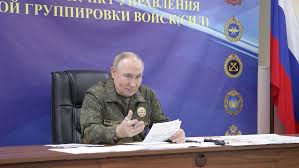Russian President Vladimir Putin has revealed that Russia has successfully test-launched a nuclear-powered cruise missile known as the 9M730 Burevestnik, codenamed “Skyfall” by NATO.
Describing it as a “weapon of unlimited range powered by a nuclear engine,” Putin claimed the missile would soon be ready for deployment. Speaking during a visit to a Russian military command post, he hailed the missile as a breakthrough in nuclear weapons technology, calling it “invincible” against current and future missile defence systems.
According to General Valery Gerasimov, Russia’s top army commander, the Burevestnik recently travelled 14,000 kilometres over 15 hours during testing. The 12-metre-long missile is reportedly capable of carrying a thermonuclear warhead and is designed for intercontinental missions.
Dubbed the “Flying Chernobyl” by Western analysts, the missile has drawn criticism over its potential environmental and safety risks due to its nuclear propulsion. Former U.S. State Department official Thomas Countryman described it as “a uniquely stupid weapon system,” warning that it may pose more danger to Russia than to other countries because of the radioactive trail it leaves behind.
The Burevestnik’s development has faced numerous setbacks, including technical failures and delays. The Nuclear Threat Initiative (NTI) reports at least 13 test attempts since 2016, with only two partial successes. In 2019, a prototype reportedly exploded during recovery, killing several engineers and releasing radiation.
Despite these challenges, Putin insisted the missile is in its final development stage and ready for front-line deployment. The Burevestnik is one of six “super weapons” unveiled by Russia in 2018, alongside the Sarmat (Satan-2) ICBM, Zircon and Kinzhal hypersonic missiles, Avangard glide vehicle, and Poseidon nuclear-powered underwater drone.
Named after the Russian word for “storm petrel,” the missile is said to possess unlimited range and manoeuvrability, and U.S. analysts suggest its miniaturized nuclear reactor allows it to theoretically circle the globe multiple times. Its low-altitude flight path could make it difficult to detect with most radar and missile defence systems.
While Putin’s announcement highlights Russian military advancement, Western intelligence remains skeptical about the missile’s operational readiness, citing concerns over its stability and control. Satellite imagery has identified what may be a secret launch site in Vologda, northern Russia.
The missile’s debut comes amid escalating conflict in Ukraine, where overnight airstrikes on Kyiv reportedly injured 26 people, including six children, and other regions saw three deaths and 29 injuries. President Volodymyr Zelensky reported that over the past week, Russia launched 1,200 drones, 1,360 bombs, and 50 missiles, underscoring the ongoing intensity of the war.




